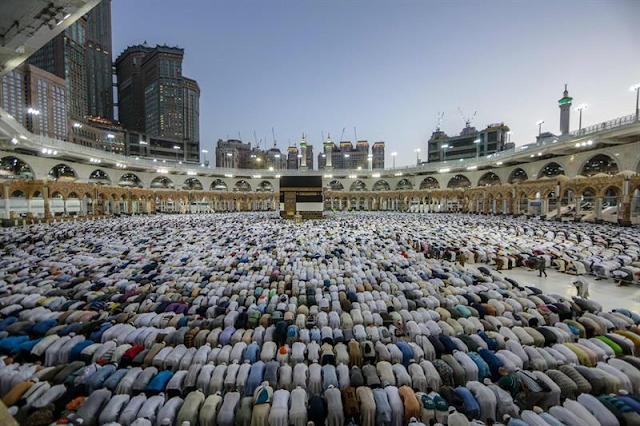Keeping the Hajj tradition alive in Egypt
A century after his grandfather's labor graced the Kaaba in Makkah's Grand Mosque, Ahmed Othman weaves golden threads into the black fabric to create Qur'anic verses under the steady hum of a ceiling fan.
The Hajj yearly trip, which begins this week, is symbolized by the ceremonial hanging of the kiswa, enormous pieces of black silk embroidered with gold designs, over the cubic structure that serves as the Grand Mosque's focal point.
The production of the kiswa used to be a privilege bestowed on Othman's family.
His family's works would be transported in a camel caravan to the holiest shrine in Islam, which is located in western Saudi Arabia and is visited by Muslims from all over the world.
Currently, Othman continues the tradition in a tiny workshop hidden above the confusing Khan Al-Khalili bazaar in the heart of Cairo, where mass-produced trinkets line the lanes. Egypt's traditional handicrafts have historically been produced in this region, but artists now confront more difficulties.
Materials, which are primarily imported, have increased in price, particularly as Egypt struggles economically and its currency has lost value.
High-quality handcrafted goods are out of reach for the typical Egyptian due to declining purchasing power, and master artisans struggle to pass down their talents as young people leave for more lucrative careers.
Hunched over one of the numerous tapestries that occupied his workshop, Othman grumbled that this wouldn't be the case "if there was excellent money in the craft."
Verse and prayers are elegantly stitched in silver and gold on sheets of black and brown felt.
Each thread recalls the "holy ritual" that Othman's grandfather was tasked with performing in 1924. Ten artisans would labor "for a whole year" on the kiswa that covers the Kaaba, which pilgrims circumambulate, using silver thread.
Beginning in the thirteenth century, Egyptian artisans created the enormous cloth in portions, which the authorities ceremoniously brought to Makkah. Egyptians would shower rosewater from balconies above as they moved through cities, escorted by soldiers and clergymen.
The last person to oversee a kiswa built entirely in Egypt was Othman Abdelhamid, Othman's grandfather, in 1926.
Manufacturing moved to Makkah in the fledgling Kingdom of Saudi Arabia starting in 1927; the country fully took over kiswa production in 1962. Later, the family embroidered military attire for guests from Egypt and beyond, including former presidents Anwar Sadat and Gamal Abdel Nasser.
My father began embroidering Qur'anic passages on tapestries "in addition to our work with military rank embroideries," and then replicated entire parts of the kiswa. The demand for "identical duplicates of the kiswa, down to the last detail," flooded the shop.
Despite the fact that they currently sell little tableaus for as little as 100 Egyptian pounds (approximately $5), larger custom orders cost several thousand dollars. One such item is a replica of the Kaaba door, which Othman proudly boasts is identical to the Makkah originals.
However, the family has not been exempt from the economic turmoil that started with the coronavirus outbreak, which wiped out Egypt's small enterprises and skilled labor.
Prior to the beginning of 2020, they would sell at least one tapestry every day, but now they only sell "two pieces every month." Othman is concerned that a feeling of "global austerity" makes it unlikely for businesses to recover.
He might only recognize the work of a dozen or fewer craftsmen now because many workers have opted to pursue other forms of income.
According to Othman, they "may take 200 to 300 pounds per day," or $10 to $16. They "are not going to sit on a loom all day, hurting their backs."
But even so, Othman claims he has stuck to the methods he learned as a boy when he would skip school to watch his father work, more than 150 years after his great grandfather left his home in Turkey and brought the trade to Egypt.



Comments
Post a Comment